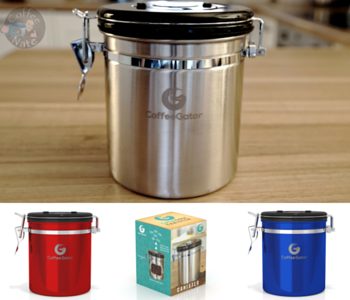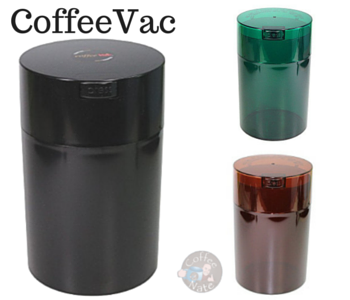

Coffee Freshness
The subject of coffee freshness has been confused by ignorant coffee companies and consumers spreading lies and mistruths. I get it; you want to trust the company you bought the coffee from, and you put a certain amount of confidence into the information they print on the packaging. Unfortunately, many of them have no clue about proper storage of roasted coffee.
Coffee’s Enemies
- Moisture
- Heat
- Light
- Oxygen
Obviously, storing roasted coffee in ways that protect against the four elements is the objective.
The Lies
Coffee should never be stored in the refrigerator. Everything in the fridge is exposed to humidity/moisture.
Many coffee companies advise consumers to store their unused beans in the freezer. Placing coffee in the freezer should be avoided because the typical person isn’t going to go through the necessary steps to ensure proper handling.
Roasted coffee is safely frozen under the following conditions;
- The coffee is moved into freezer-safe storage
- The coffee is frozen once
- The coffee is placed in a deep-freeze, not a kitchen freezer that is opened/closed daily
You can divide a large amount of coffee into smaller, week’s worth portions, placing each portion into freezer-safe containers. At the beginning of each week, remove one package from the freezer. Allow the frozen coffee to reach room temperature before grinding/brewing.
The Bean – A Freshness Container
A whole coffee bean acts as a protector of freshness. It shields the delicate oils from the outside elements. With typical consumer storage, whole bean coffee remains fresh for about two weeks.
When ground, the coffee immediately begins to spoil. The oils come into contact with oxygen. Air destroys the coffee, and the oils become rancid. This is why I say there is no *best* way to store ground coffee. To provide an answer would be like prescribing the best way to store curdled milk. It doesn’t matter what you do; it’s still going to be spoiled.
The Best Storage For Roasted Coffee
If you purchase fresh roasted, whole bean coffee, there are special containers you can purchase to prolong the freshness of the coffee. These containers provide protection from the four coffee freshness enemies.
After the roasting process, the coffee beans emit significant amounts of carbon dioxide. That is why you see valves on bags of roasted coffee. A lot of people think those valves are for vacuum sealing. They are one-way valves, allowing the CO2 to escape, while keeping the outside air from getting in.
After Opening
After opening the package, it is important to provide shelter from moisture, air, light, and heat. I’ve used two inexpensive options to store my coffee. They are opaque containers that effectively seal the beans inside, while providing a one-way valve for the CO2 to escape. I have complete confidence in both containers, and I continue to use them.
Place the amount of coffee you wish to store inside of the container, seal them, then put the container in an area that is not subject to temperature changes (i.e., sun exposure, near entry doors, etc.)
Here are my preferred coffee storage containers;
Coffee Gator
 The Coffee Gator is a simple storage container. It is a sort of coffee croc. The lid contains a one-way valve to allow the carbon dioxide a way out, without allowing air to enter the container. One-way valves are especially desirable if you’re going to keep the container sealed for multiple days. Operating the Coffee Gator quite easy, just push the lid down and flip the hasp. It doesn’t take much pressure or dexterity to engage the seal, so it shouldn’t be an obstacle for those with limits in those areas. Coffee Gator website
The Coffee Gator is a simple storage container. It is a sort of coffee croc. The lid contains a one-way valve to allow the carbon dioxide a way out, without allowing air to enter the container. One-way valves are especially desirable if you’re going to keep the container sealed for multiple days. Operating the Coffee Gator quite easy, just push the lid down and flip the hasp. It doesn’t take much pressure or dexterity to engage the seal, so it shouldn’t be an obstacle for those with limits in those areas. Coffee Gator website
CoffeeNate readers will enjoy an exclusive discount of 15% when using coupon code: TYE3NCTE
The lid also provides two dials, one from 1-12 and the other from 1-31. You can use this to help keep track of when you began storing your beans.
CoffeeVac
 The CoffeeVac works in much the same way, although its construction is plastic instead of stainless steel. I’ve had several CoffeeVac’s, which are available in several sizes. They are not as sturdy as the Coffee Gator, but they do work well. I would especially recommend the CoffeeVac if you’re storing smaller amounts of coffee, as you can store it with less air getting trapped inside of the container. Operate the CoffeeVac by pushing a button while sliding on the lid. You can hear the air being displaced and verify that the seal is working by attempting to remove the lid without depressing the button.
The CoffeeVac works in much the same way, although its construction is plastic instead of stainless steel. I’ve had several CoffeeVac’s, which are available in several sizes. They are not as sturdy as the Coffee Gator, but they do work well. I would especially recommend the CoffeeVac if you’re storing smaller amounts of coffee, as you can store it with less air getting trapped inside of the container. Operate the CoffeeVac by pushing a button while sliding on the lid. You can hear the air being displaced and verify that the seal is working by attempting to remove the lid without depressing the button.
Find other products that I recommend in the CoffeeNate Shop!




